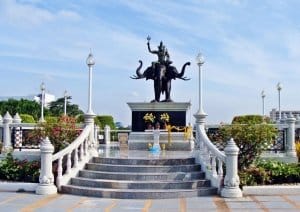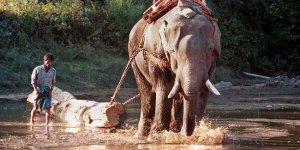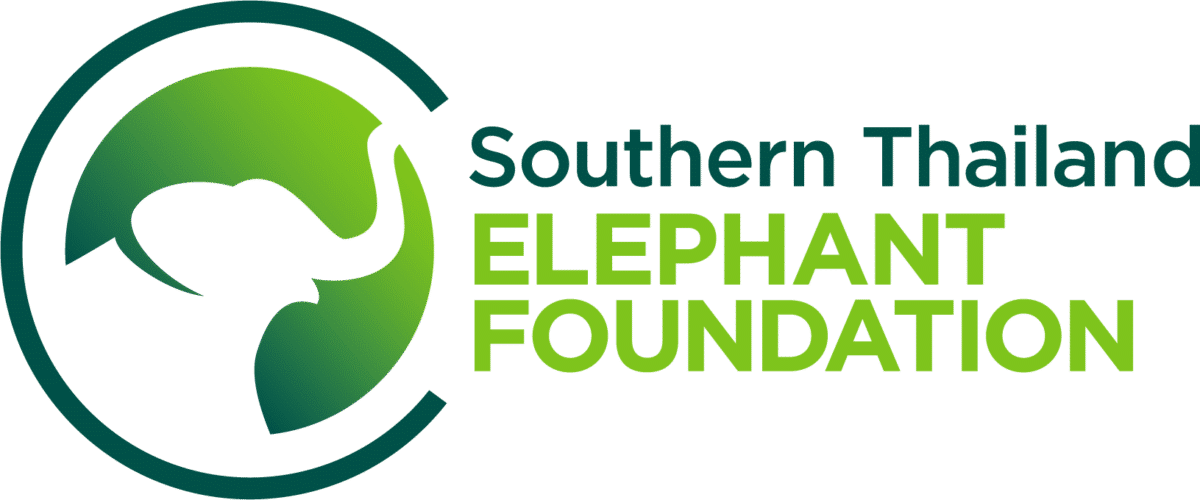A Fascinating insight into the history of Elephants in Thailand’s culture
In Thailand, elephants historically represent strength, loyalty and longevity. Today they feature in art, adverts, architecture and flags.
Their intelligence has long been associated with the enlightened Buddha, making them guardians of Earth. Thai records of elephants being domesticated (for combat) date to the 1200s, but this use somewhat faded between the 1500s and 1800s. They were subsequently used in logging, working to clear thick jungle where mechanisation was impossible. The elephants were ideally suited to this role and largely coped well with it, although sadly some were overworked and died prematurely.

Statue of three-headed elephant with the God Indra, in Bangkok
The Thai government implemented a commercial logging ban in 1989, protecting forestry and helping save wild elephants from habitat loss, but this left 3,000 domesticated elephants that owners had to support financially and provide up to 250-300 kg of feed daily. The booming tourism industry provided employment opportunities, but too many elephants were mistreated and Kwan-changs (elephant carers) were generally underpaid. Ethical tourism is the best way to look after Kwan-changs and their families while caring for such elephants. Domesticated elephants are human-dependent, and it is very difficult to return them to the wild.

Elephants were used for logging in Thailand until it was banned
The Thai government Beasts of Burden Act 1939 designates captive elephants as ‘working animals’, so instead of being ‘rescued’ when they are being neglected or maltreated, they must be bought. This has caused problems in finding good homes but a lot of work is underway to raise education levels and establish proper training courses and standards for elephant care across Thailand. Tourism remains vital to conserve the Thai elephant population, which has fallen to around 10% of what it was 100 years ago, but it must be welfare driven.
A Kwan-chang has to understand his elephant’s behaviour, mood and health. It takes years to build a trusting bond, where each elephant responds to their Kwan-chang’s voice. Traditionally, Kwan-changs were paired 1-1 with elephants, often for life, and happily there are still some who want to do nothing else (see this short video clip here), but it is increasingly hard in the modern day to find enough young men able to devote a full career to this way of life. Also, some elephant camps provide poor working conditions and little training; here workers may not bond adequately with the elephants, leading to accidents and unnecessary abuse. Education and training is are therefore key.
The Thai government banned wild elephant capture and trade in 1992. Since 2015, captive elephants must be DNA registered. This guarantees their origin, preventing illegal trafficking. Environmental groups and the Thai Royal Family campaign for eco-friendly agriculture, helping protect the remaining forest. STEF will grow elephant food sustainably, using converted farmland.

Land at Ban Ton Sae being planted for elephant habitat
Charities like STEF will provide free veterinary treatment for domesticated elephants. This is especially important as the ex-logging generation gets older. STEF aims to develop skilled Kwan-changs by supporting training and education, and to promote elephant welfare in the wider community by teaching about elephant care and the importance of conservation through breeding.
You can help STEF by: Donating – 100% of the money we receive goes towards the elephants; Visit Fundraising or promoting, or please e-mail info@southernthailandelephants.org to find out about volunteering opportunities.

Dr Andrew Higgins, Chairman of STEF
[This journal post is a summary of an article written by one of our Volunteers, Holly Collicott. For more information on elephant traditions in Thailand and ongoing conservation projects, please click here.]
Historical photos from Pixabay and Wikimedia
An Elephant’s Favourite Thing – Food!
Elephants are herbivores. This means that they have a plant-based diet and eat a lot. Read on to find out how these gentle giants make more than a meal from the surrounding plants of the jungle.


Elephants like variety, however, and an individual can eat over 100 different plant species throughout the year, including grasses, leafy plants, sedges, woody plants, bark, fruits and flowers. As generalist feeders, their diet is flexible depending on what is available for the time of year and region. They are also selective grazers and are taught by their mothers to avoid plants that are toxic or might cause digestive disturbances.
Elephants have been observed learning what to eat during different seasons. For example, they preferentially eat grasses in the wet season, when grasses have higher protein levels. This intelligent feeding pattern also helps elephants build up their nutrient reserves, protecting themselves from seasonal fluctuations.

This activity creates habitats and food sources for hundreds of other species to thrive. Asian elephants are a flagship species: by protecting them, we can protect whole ecosystems. Many human activities are reducing the food sources available for elephants; climate change is expected to increase severity of heavy rains and frequency of drought.
What about Captive Elephants?


The concentrations of protein, minerals and vitamins in plant matter decrease with age, so it is important to feed elephants fresh material and also to allow them to freely browse diverse natural vegetation.
Find out more:
Elephant World. (2019). Elephant Feeding. Available: https://www.elephant-world.com/elephant-feeding/. Last accessed 09.11.19.
Phang Nga Elephant Park. (2015-2019). Asian Elephant Profile. Available: https://phangngaelephantpark.com/asian-elephant-profile/. Last accessed 09.11.19.
Further References:
Koirala, R.K et al. (2016). Feeding Preferences of the Asian Elephant (Elephas maximus) in Nepal. BMC Ecology. 16 (54).
Sukumar, R. (1993). Nutrition and Foraging. In: Eltringham, S.K et al The Asian Elephant: Ecology and Management. Cambridge: Cambridge Studies in Applied Ecology & Resource Management) (Cambridge Studies in Applied Ecology and Resource Management. p82-83.


Like humans taking multivitamins, elephants can be kept healthy with nutrient supplements. Every elephant keeper has his own ideas about the best supplements, but they are often made from a mixture of ground feed pellets, containing minerals and vitamins, plus water so they are not too dry. Mashed bananas make them delicious and help to combine the mixture into balls, 
STEF has been teaching local Thai children about elephant welfare on its sponsored activity days at Phang Nga Elephant Park as part of our PLACE2C programme which we hope will empower children to learn about and work with elephants in ethical, sustainable ways in the future.

Wild elephants get much of their essential minerals through eating mineral-rich soil or digging for salt licks located on their foraging routes. These provide sodium and other minerals such as calcium and magnesium that are vital to their health.
Scientists agree that more studies are required into the mineral requirements of elephants, but here are a few of the minerals and vitamins that elephants need to keep them healthy. Here are some of the important nutrients and why they are vital for life:
| Nutrient: | Can be found in: | Some of the important roles: |
| Sodium | Soil,
salt deposits |
For the proper function of the nervous system, the bioelectrical network behind movement and brain activity
As an essential electrolyte, to help ensure elephants absorb enough of the 200 L of water they drink daily, so maintaining blood pressure and hydration |
| Iron | Grasses, leaves, twigs | A component of haemoglobin, the protein that carries oxygen throughout the body. Oxygen is essential for life, breaking down sugars, releasing energy for growth, maintenance, repair and movement |
| Phosphorus | Leaves and grasses | Binds calcium to form bones and cartilage so any deficiency can lead to weakened bones and joints
Forms reactive components needed to break down sugars, releasing energy for growth, repair and movement |
| Calcium | Bark, leaves, leguminous plants | Forms strong bones and cartilage so a deficiency can lead to bone and joint disease
Stimulates hormone secretion, immune defences, nervous activity for thinking and movement, muscle contraction for movement and heart activity, blood clotting at wounds |
| Vitamin B | Made by a range of gut bacteria | Makes fatty insulation for nerves so they can transmit signals for thinking and movement
Maintains healthy skin ensuring good growth of foot-pads and toenails, so lessening chance of lesions and cracks which can impair mobility |
| Vitamin E | Leaves and grasses | As an antioxidant, scavenges reactive metabolic products that can attack body tissues, protecting integrity and activity of the immune and nervous systems and muscles
Stimulates tissue repair and wound healing
|
What Must be Done Now?
Only 10% of forested elephant habitat remains in Thailand; most land is now dedicated to crops for human consumption which don’t meet elephants’ nutritional needs. At STEF, we grow elephant food sustainably on our land at Klok Kloi, near Phuket. Farming optimally-cultivated food for elephants needs to be encouraged, along with reduced use of pesticides and fertilisers.
Like humans, elephants have individual dietary needs and, like humans, some of them are just picky! Elephants support their development and changing activities by changing what they eat.





What future developments could improve captive elephant nutrition?
By analysing biochemical compositions, specific plant species could be identified with high concentrations of key nutrients.
By analysing regular blood samples from elephants in our laboratory, we will also be able to optimise diets for their individual needs.
Find out more:
International Plant Nutrition Institute. (1999). Phosphorus in Animal Nutrition. Better Crops With Plant Food. 83 (1), p32-33.
Phang Nga Elephant Park. (2015-2019). Appearance and Intelligence. Available: https://phangngaelephantpark.com/appearance-and-intelligence/. Last accessed 09.11.19.
Further references:
Association of Zoos & Aquariums (2012). AZA Standards for Elephant Management and Care. 2nd ed. USA: Association of Zoos & Aquariums. p28.
Koirala, R.K et al. (2019). The Effects of Age, Sex and Season on the Macronutrient Composition of the Diet of the Domestic Asian Elephant. Journal of Applied Animal Research. 47 (1), 5-16.
van Baarlen, I; Gerritsen, M (2012). Elephant Nutrition in Dutch Zoos. The Netherlands: University of Applied Sciences.

Digestive problems are extremely dangerous in both wild and captive elephants – did you know that something that seems as ‘ordinary’ as constipation or diarrhoea can kill an elephant? Read on to see why…
For any elephant, maintaining a healthy digestive system is not easy, but it is so important. Because of their plant-based diet, elephants need a healthy gut, containing a range of helpful microbes which slowly digest plant fibre (cellulose). This produces fatty acids, which the elephant can absorb for energy. If an elephant eats too much fibrous material at once, this can slow digestion so much that it can diminish appetite and prevent them from eating enough.

With captive elephants, colic can also be caused by feeding too many or badly formulated supplements or pellet balls, and also by internal parasites, or sudden changes to either diet (upsetting gut bacteria) or routine (upsetting the elephant). Elephant care is a challenge requiring complete dedication, observation and sensitivity.
Caring for domestic elephants:


It is important for elephants to be allowed to roam freely and get plenty of exercise to stimulate motility in the gut and keep their metabolisms working. It also helps keep them in shape – a big concern surrounding captive elephants is 

Each kwan-chaang should also inspect his elephant’s dental health daily, which requires a very trusting relationship! Elephants have six sets of teeth throughout their life. They must eat enough fibrous roughage to naturally wear down each set and work out old teeth to make room for the new ones.
Find out more:
Phang Nga Elephant Park (2015-2019). Appearance and Intelligence. See: https://phangngaelephantpark.com/appearance-and-intelligence/
Saint Louis Zoo (2003-2019) See: https://www.stlzoo.org/animals/abouttheanimals/mammals/asianelephant/elephantedibles
Association of Zoos & Aquariums (2012). AZA Standards for Elephant Management and Care. 2nd ed. USA: Association of Zoos & Aquariums. p28.
Hatt, J.M; Clauss, M. (2006). Feeding Asian and African Elephants in Captivity. International Zoo Yearbook. 40 (Elephants and Rhinoceros), 88-95.
Hile, E.M., Hintz, H.F., Hollis, N. (1997). Predicting body weight from body measurements in Asian elephants (Elephas maximas). Journal of Zoo and Wildlife Medicine 23, 205-210
The rains brought their challenges, 

The lotus (bua in Thai) is important in the everyday life of the Thai people and is the traditional flower of Buddhism. Legend has it that when the Lord Buddha took his first steps, lotus blooms opened up to cushion the soles of his feet. With its roots in the mud, the plant rises above the dirty water to yield a flower of perfect beauty and purity. Indeed, for Buddhists, the flower stands for pureness of spirit and the flowers are widely used as offerings at shrines, in spirit houses and in the temple.


The lotus is undeniably beautiful and adds charm to the surroundings. We want the lotus to be visible part of our Thai world at Ban Ton Sae, where the Thai culture must never be forgotten.
Southern Thailand Elephant Foundation
Lakin Rose,
Pioneer House, Chivers Way,
Histon, Cambridge,
CB24 9NL, UK
Email: info@southernthailandelephants.org
Tel: 07440 514362
Registered charity number: 1176322
Fundraising Regulator

